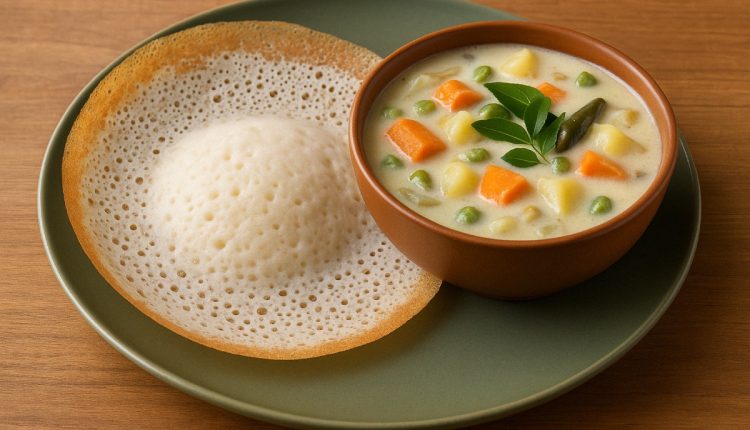Soft, lace-edged, and pillowy at the center, Appam is one of Kerala’s most beloved dishes, and when paired with a warm, creamy vegetable or meat stew, it transforms into a soulful experience. This heavenly pairing is a breakfast staple in Syrian Christian households and a festive favorite served at weddings, special occasions, and leisurely Sunday mornings across the state.
With roots deep in Kerala’s rich culinary history, Appam with Stew is more than a meal—it’s a celebration of subtle flavors, heritage, and warmth.
What Is Appam?
Appam (sometimes called palappam) is a type of rice pancake, made from a fermented batter of rice, coconut milk, and a touch of sugar, cooked in a special pan known as an appachatti. The batter spreads into a thin, lacy edge while the center remains soft and spongy.
Its mild flavor and soft texture make it a perfect base for soaking up rich and aromatic curries.
What Is Kerala Stew?
Stew in Kerala cuisine refers to a coconut milk-based curry that’s gently spiced and loaded with vegetables or meat—commonly chicken or mutton. The key feature of this stew is its delicate flavor. Unlike fiery Indian curries, this one is soothing, creamy, and aromatic.
Variants of Stew:
-
Vegetable Stew – Mixed veggies like carrot, beans, potatoes, and peas in coconut milk.
-
Chicken Stew – Tender chicken pieces simmered in mildly spiced coconut gravy.
-
Mutton Stew – Rich and hearty, often served on festive occasions.
Curry leaves, green chilies, ginger, black pepper, cinnamon, and cardamom form the mild spice base, while thick and thin coconut milk give it that creamy, comforting texture.
The Perfect Pairing
Appam and stew make a perfect yin-yang combination:
-
The neutral softness of appam balances the spiced richness of the stew.
-
The spongy center soaks up the coconut gravy, while the crispy edges offer contrast in texture.
It’s comfort food at its finest—light on the stomach, yet rich in taste and tradition.
Cultural Roots and Influence
Appam and stew are deeply rooted in the Syrian Christian culinary tradition of Kerala, especially around Kottayam, Kochi, and Alappuzha. However, the dish has transcended community lines and is now enjoyed across the state, regardless of region or religion.
The use of coconut milk and spices is reflective of Kerala’s tropical climate and abundant spice trade history.
Health Benefits
Appam and stew might be indulgent in flavor, but they’re also surprisingly wholesome:
-
Appam is fermented, aiding digestion and promoting gut health.
-
Stew uses minimal oil and spices, making it heart-friendly and ideal for all age groups.
-
Coconut milk offers healthy fats and adds a dose of essential minerals like magnesium and potassium.
How It’s Served
This dish is usually served:
-
Hot off the stove, with appams made fresh to order.
-
Stew served in earthen pots or steel bowls to retain heat.
-
Commonly eaten by hand, though a spoon is often used for the stew.
It’s also served at Kerala-style restaurants, Christian weddings, Easter breakfasts, and even Onam or Vishu spreads in some homes.
Pro Tips for Making It at Home
-
For Appam Batter: Soak raw rice and grind with cooked rice and coconut milk. Ferment overnight.
-
Use a well-seasoned appachatti to get that signature lacey edge.
-
For Stew: Don’t over-boil coconut milk—it may split. Always add thick coconut milk at the end.
-
Ginger and green chili should be the dominant flavors, not heavy spices.
Where to Eat Authentic Appam with Stew
If you’re in Kerala, don’t miss these places:
-
Kethal’s Chicken, Thiruvananthapuram
-
Hotel Rahmaniya, Kozhikode
-
Fort House Hotel, Kochi
-
Paragon Restaurant (various locations)
Across India and abroad, many South Indian restaurants now offer this dish as a Sunday or weekend special.
Final Thoughts: Simplicity at Its Finest
In a world of complex, spice-heavy cuisine, Appam with Stew stands out for its graceful simplicity. It reflects the slow, thoughtful approach to food that Kerala is known for—where ingredients are respected, and meals are prepared with care.
Whether you’re starting your morning with it or enjoying it as a comforting dinner, this iconic duo will always bring a smile to your face and warmth to your heart.


Comments are closed.